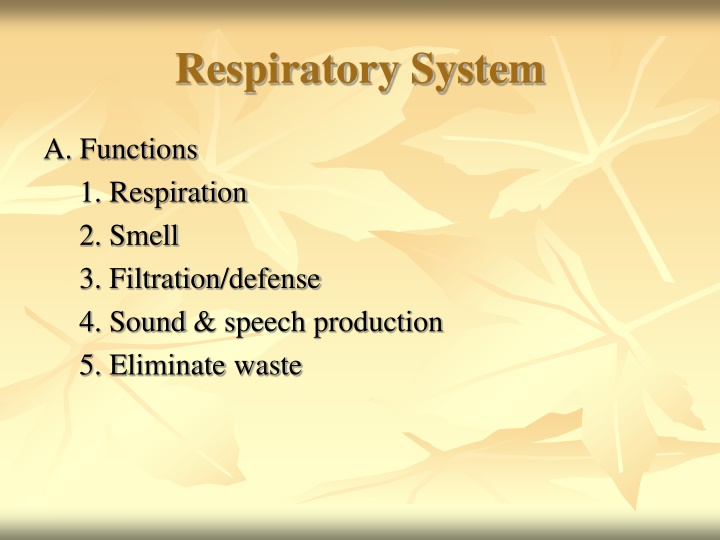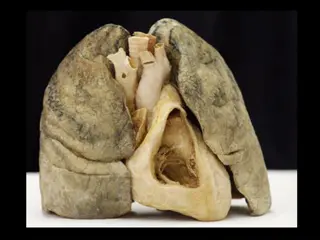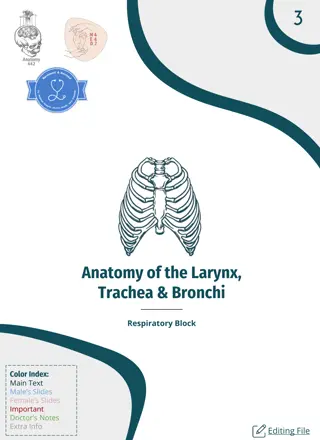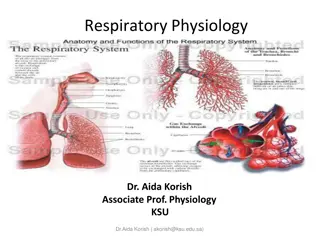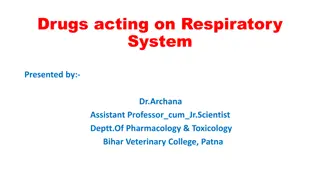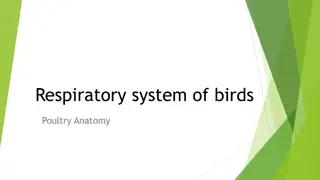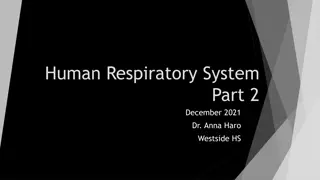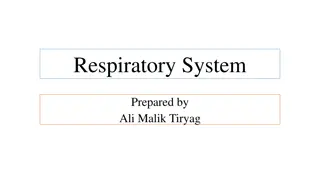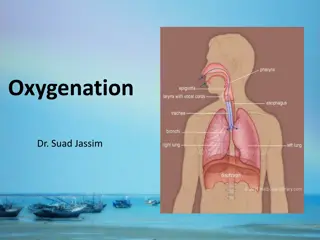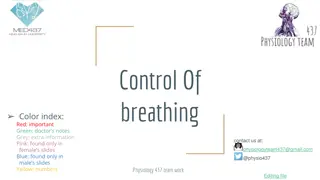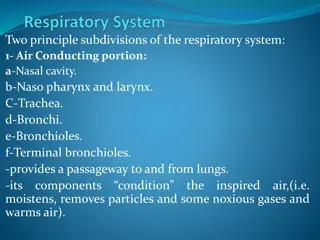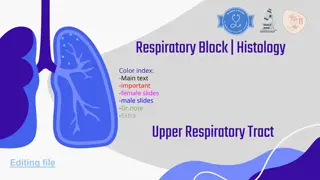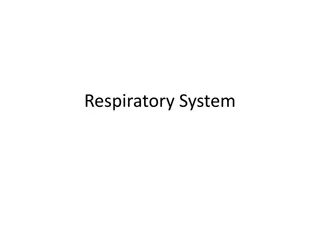Overview of the Respiratory System Functions and Anatomy
The respiratory system has vital functions such as respiration, smell, filtration/defense, sound & speech production, and waste elimination. It consists of external (root, bridge, apex, and nostrils) and internal components (nasal cavity, pharynx, larynx). The nose/nasal cavity provides an airway for respiration, filters incoming air, warms and moistens air, aids speech, and houses olfactory receptors. The pharynx includes nasopharynx, oropharynx, and laryngopharynx, serving as passageways for air and food. The larynx extends from the hyoid bone to the trachea, facilitating an open airway, routing air and food correctly, housing vocal folds, and initiating the cough reflex.
Download Presentation

Please find below an Image/Link to download the presentation.
The content on the website is provided AS IS for your information and personal use only. It may not be sold, licensed, or shared on other websites without obtaining consent from the author.If you encounter any issues during the download, it is possible that the publisher has removed the file from their server.
You are allowed to download the files provided on this website for personal or commercial use, subject to the condition that they are used lawfully. All files are the property of their respective owners.
The content on the website is provided AS IS for your information and personal use only. It may not be sold, licensed, or shared on other websites without obtaining consent from the author.
E N D
Presentation Transcript
Respiratory System A. Functions 1. Respiration 2. Smell 3. Filtration/defense 4. Sound & speech production 5. Eliminate waste
Respiratory System B. Anatomy of the Respiratory System 1. Nose/Nasal Cavity A) Functions 1) Provide airway for respiration 2) Filter incoming air 3) Warm and moisten incoming air 4) Aids in speech 5) Location of olfactory receptors
Respiratory System B) Has external and internal components C) External components 1) Root 2) Bridge 3) Apex 4) External nares or nostrils D) Internal components 1) Nasal cavity divided into 2 sections by the nasal septum
Respiratory System a) Roof is composed of ethmoid and sphenoid bones b) Floor is composed of the hard and soft palates c) Each side is further divided into sections by the superior, middle, and inferior concha i) These cause air to swirl causing particles to become trapped in mucus 2) Internal nares openings between the nasal cavity and pharynx
Respiratory System 2. Pharynx throat A) Composed of 3 regions 1) Nasopharynx a) Is continuous with nasal cavity b) Normally serves as a passageway for air only c) Blocked by soft palate and uvula during swallowing
Respiratory System 2) Oropharynx a) Lies posterior to oral cavity from soft palate to tip of the upright epiglottis b) Passageway for both food and air 3) Laryngopharynx a) Lies posterior to the upright epiglottis and extends to esophagus/trachea b) Passageway for both food and air
Respiratory System 3. Larynx voice box A) Extends from hyoid bone to the trachea B) Main functions 1) Provide open airway 2) Acts as a switching mechanism to route food and air down correct paths 3) Location of the vocal folds (cords) speech 4) Initiation of the cough reflex caused when something other than air enters the trachea
Respiratory System C) Composed of nine pieces of cartilage 1) Largest piece is the thyroid cartilage causes protrusion = laryngeal prominence (Adam s apple) 2) Epiglottis blocks trachea during swallowing 3) 3 paired cartilages arytenoid, cuneiform & corniculate 4) Cricoid cartilage is the inferior-most piece
Respiratory System D) Glottis opening between the vocal folds within the larynx 4. Trachea windpipe A) Extends from larynx until it branches B) Is ciliated and produces mucus to help trap particles in inspired air C) Tracheal rings rings of hyaline cartilage that provide strength and support
Respiratory System 5. The Respiratory Tree structures serve as a conduit for air A) Right and left primary bronchi 1) Initial branches of the trachea B) Secondary bronchi C) Tertiary bronchi D) Continues branching (up to 23 times)
Respiratory System E) Bronchioles 1mm diameter 1) Continue to branch and get smaller F) Terminal bronchioles < 0.5mm 6. The Respiratory Zone structures where gas exchange occurs A) Respiratory bronchioles (contain alveoli) B) Alveolar sacs cluster of alveoli
Respiratory System C) Alveoli 1) Actual site of gas exchange 2) About 300 million per lung 3) Coated in surfactant a) Detergent-like lipoprotein chemical b) Reduces surface tension of the water in the alveoli and prevents the alveoli from collapsing upon themselves
Respiratory System C. Respiration Breathing, Exchange, Transport 1. Inspiration (Inhalation) A) Result of a pressure difference between: 1) Atmospheric pressure 2) Intrapulmonary pressure B) Boyle s Law the pressure exerted by a gas varies inversely to its volume C) Mechanism 1) Diaphragm & external intercostals
Respiratory System 2. Expiration (Exhalation) A) Normal/restful (tidal) expiration B) Exercise or forced expiration 1) Abdominals & internal intercostals 3. Gas exchange (O2& CO2) A) Dictated by Dalton s Law the total pressure exerted by a mixture of gases is the sum of the pressures exerted independently by each gas in the mixture 1) Partial pressure
Respiratory System B) A partial pressure difference is necessary at all locations where gases are exchanged 1) Alveoli & blood 2) Blood & cells C) pO2is lowest in the cells and increases as you move up the respiration pathway D) pCO2 is highest in the cells and decreases as you move up the respiration pathway
Respiratory System E) Rate of gas exchange is affected by: 1) Partial pressure difference 2) Gas solubility 3) Surface area 4) Diffusion distance
Respiratory System 4. Transport of Gases A) O2transport 1) 2 main forms a) Dissolved in plasma 1.5% b) Bound to hemoglobin (Hb) 98.5% i) Hb + O2= HbO2(oxyhemoglobin)
Respiratory System 2) The RBC s affinity for O2 is affected by: a) pH decreased pH causes decreased affinity b) pCO2 increased pCO2causes decreased affinity c) Temperature increased temp causes decreased affinity
Respiratory System B) CO2transport 3 basic forms 1) Dissolved in plasma 7% 2) Bound to hemoglobin 23% a) Hb + CO2= HbCO2 (carbaminohemoglobin) 3) Bicarbonate (HCO3-) ions 70%
Respiratory System a) Forms in RBC CO2+ H2O H2CO3 H++ HCO3- i) HCO3-leaves the RBC ii) Chloride shift Cl-moves into RBC iii) H+binds with hemoglobin
Respiratory System b) Process reverses in the lungs CO2+ H2O H2CO3 H++ HCO3- i) HCO3-enters the RBC ii) H+breaks from hemoglobin and binds with HCO3- iii) Reverse chloride shift Cl-moves out of the RBC
Respiratory System 5. Control of Respiration A) Respiratory Center 1) Dorsal Respiratory Group (DRG) dominant group a) Stimulates the diaphragm and external intercostals i) Sets the tidal (resting) breathing rhythm (eupnea) (a) 2 sec. inhalation/3 sec. exhalation (b) 12-15 breaths/min
Respiratory System a) Integrates input from peripheral stretch and chemoreceptors i) Stimulates the VRG when ventilation demands increase 2) Ventral Respiratory Group (VRG) a) Stimulates the accessory inspiratory and expiratory muscles (abdominals & internal intercostals) when necessary
Respiratory System 3) Apneustic center a) Helps coordinate transition from expiration to inspiration b) It stimulates the DRG to initiate inspiration during both restful and forceful breathing
Respiratory System 4) Pneumotaxic center a) Helps coordinate transition from inspiration to expiration b) It inhibits the apneustic center to promote restful or forceful expiration as needed c) Along with the apneustic center, it helps modify and fine-tune breathing during activities such as speaking, singing, sleeping, and exercising
Respiratory System B) The respiratory center is influenced by: 1) Higher brain centers (conscious control) 2) Stretch receptors in lungs 3) Irritant receptors in trachea & lungs 4) Chemoreceptors in brain a) Detect CO2 &H+in the blood 5) Chemoreceptors in aortic arch and common carotid arteries a) Detect O2, CO2&H+ in the blood
Respiratory System 6. Respiratory Air Volumes A) Respiratory Volumes 1) Tidal volume (TV) the amount of air inhaled or exhaled with each breath under resting conditions 2) Inspiratory reserve volume (IRV) the amount of air that can be forcefully inhaled after a normal tidal volume inhalation
Respiratory System 3) Expiratory reserve volume (ERV) the amount of air that can be forcefully exhaled after a normal tidal volume exhalation 4) Residual volume (RV) amount of air remaining in the lungs after a forced exhalation 5) Dead Space Volume (DSV) amount of air in the respiratory pathway not involved in gas exchange
Respiratory System B) Respiratory capacities 1) Total lung capacity (TLC) the sum of all respiratory volumes 2) Vital capacity (VC) the total amount of exchangeable air
Respiratory System 7. Breathing Patterns A) Eupnea normal breathing B) Apnea transient cessation of breathing C) Dyspnea difficult, labored, or painful breathing 1) Often indicates lung infection/injury
Respiratory System D) Hyperventilation 1) Can result in respiratory alkalosis E) Hypoventilation 1) Can result in respiratory acidosis
Respiratory System 8. Respiratory Disorders A) Sinusitis inflamed sinuses from a nasal cavity infection B) Laryngitis inflammation of the vocal cords C) Pharyngitis (strep throat) inflammation of the pharynx; caused by Streptococcus bacteria D) Pleurisy inflammation of the pleural membranes E) Pneumothorax air in the intrapleural spaces F) Atelectasis lung collapse
Respiratory System G) Carbon Monoxide Poisoning CO binds with Hb in place of O2 H) Pneumonia infectious inflammation of the lungs (usually bacterial but can also be viral or fungal) I) Emphysema permanent enlargement of the alveoli due to destruction of the alveolar walls J) Chronic bronchitis inhaled irritants lead to chronic excessive mucus production as well as inflammation and fibrosis of the mucosa
Respiratory System K) Asthma bronchoconstriction prevents airflow into the alveoli L) Tuberculosis an infectious disease caused by the bacterium Mycobacterium tuberculosis resulting in fibroid masses in the lungs M) Cystic Fibrosis genetic disorder that causes an increase in mucus production resulting in clogged respiratory passages
Respiratory System N) Infant Respiratory Distress Syndrome (IRDS) alveoli collapse between breaths causing labored breathing and sometimes inadequate respiration 1) Usually seen in premature infants
